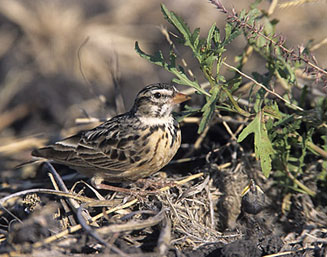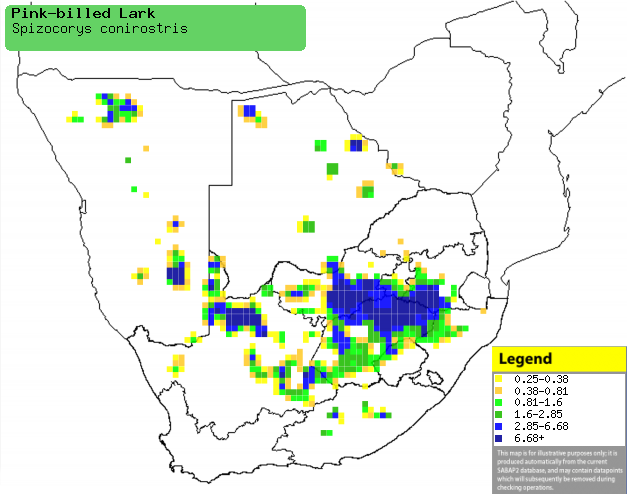|
Spizocorys conirostris (Pink-billed
lark)
Pienkbeklewerik [Afrikaans]; Ruruworo, Tjowe (generic terms
for sparrowlark and Pink-billed lark) [Kwangali]; Roodsnavelleeuwerik
[Dutch]; Alouette à bec rose [French]; Rotschnabellerche [German];
Cotovia-de-bico-rosado [Portuguese]
Life
> Eukaryotes >
Opisthokonta
> Metazoa (animals) >
Bilateria >
Deuterostomia > Chordata >
Craniata > Vertebrata (vertebrates) > Gnathostomata (jawed
vertebrates) > Teleostomi (teleost fish) > Osteichthyes (bony fish) > Class:
Sarcopterygii (lobe-finned
fish) > Stegocephalia (terrestrial
vertebrates) > Tetrapoda
(four-legged vertebrates) > Reptiliomorpha > Amniota >
Reptilia (reptiles) >
Romeriida > Diapsida > Archosauromorpha > Archosauria >
Dinosauria
(dinosaurs) > Saurischia > Theropoda (bipedal predatory dinosaurs) >
Coelurosauria > Maniraptora > Aves
(birds) >
Order: Passeriformes > Family: Alaudidae
> Genus: Spizocorys
 |
|
|
Pink-billed lark, Kgalagadi Transfrontier Park,
South Africa. [photo Trevor Hardaker ©] |
|
Distribution and habitat
Near endemic to southern Africa, its distribution extends
from patches in western Zambia to Namibia, Botswana and South Africa. It
generally prefers open, short grassland (often recently burnt), Kalahari sand
dunes with dense grass cover and fallow fields and croplands shortly after
harvesting.
|
 |
|
Distribution of Pink-billed lark in southern Africa,
based on statistical smoothing of the records from first SA Bird Atlas
Project (©
Animal Demography unit, University of
Cape Town; smoothing by Birgit Erni and Francesca Little). Colours range
from dark blue (most common) through to yellow (least common).
See here for the latest distribution
from the SABAP2. |
Movements and migrations
Resident and sedentary throughout most of its
distribution, although in Namibia it is nomadic, searching for areas
which have had recent rainfall.
Food
It eats invertebrates and grass seeds, doing most of its
foraging on the ground, pecking food items from the soil.
Breeding
- The nest is a cup built of dry grass and rootlets and lined with finer
material; the rim is often extended to form an "apron" surrounding the cup,
especially in the arid west. It is typically placed in a scrape or hoofprint
in the ground, usually propped against a grass tuft, shrub or clod of earth.
- It is an opportunistic breeder, lay its eggs after rainfall at any time
of year.
- It lays 1-3 eggs, which are incubated for about 11-13 days.
- The chicks are fed by both adults, leaving the nest after about 10 days,
before they are able to fly.
Threats
Not threatened.
References
-
Hockey PAR, Dean WRJ and Ryan PG 2005. Roberts
- Birds of southern Africa, VIIth ed. The Trustees of the John Voelcker
Bird Book Fund, Cape Town.
|
